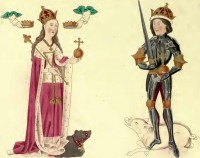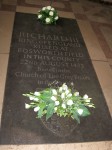Now that the press conference is over, the University of Leicester has released a detailed statement on the find, new pictures, an excellent video illuminating the timeline of the excavation and awesomely, a five-panel artistic rendering of Richard’s death, burial and (potential) exhumation done in what I can only describe as a combination manga and stained glass style.
We start with the extensive press release. The statements from Richard Taylor and Peter Soulsby are the ones they made during the press conference. One interesting side note that I didn’t catch while live blogging is the reference to a period source for the location of Richard’s burial. Taylor quotes John Rous reporting that Richard was “at last was buried in the choir of the Friars Minor at Leicester.”
 John Rous was the priest of the chapel of St. Mary Magdalen at Guy’s Cliffe which was built in 1423 by Richard Beauchamp, Earl of Warwick. The Beauchamps were Rous’ patrons, whom he served as chaplain from around 1445 until his death in 1491. He was therefore a contemporary of King Richard III’s and may have even known him, or at least seen him, since Richard traveled to Warwick several times.
John Rous was the priest of the chapel of St. Mary Magdalen at Guy’s Cliffe which was built in 1423 by Richard Beauchamp, Earl of Warwick. The Beauchamps were Rous’ patrons, whom he served as chaplain from around 1445 until his death in 1491. He was therefore a contemporary of King Richard III’s and may have even known him, or at least seen him, since Richard traveled to Warwick several times.
Rous was an avid antiquarian and historical researcher. He wrote a history of the Earls of Warwick between 1477 and 1485, and a history of the kings of England after 1485. The former voices strong support for the Yorkist faction, including describing Richard as a king who ruled “full commendably, punishing offenders of his laws, and oppressors of his Commons, and so cherishing those that were virtuous that he got great thank of God and love of all his subjects, both rich and poor, and great laud of the people of all other lands about him.” Once England’s political fortunes changed after Bosworth and the ascension of Henry Tudor, Rous’ description of Richard changed too. Drastically. From the Historia Regum Anglie:
“Richard of York … was retained within his mother’s womb for two years, emerging with teeth and hair to his shoulders … like a scorpion he combined a smooth front with a stinging tail. He was small of stature, with a short face and unequal shoulders, the right higher and the left lower….”
You can see why Philippa Langley of the Richard III Society thinks the Tudor version of Richard is a myth bearing little resemblance to reality. Philippa, incidentally, was instrumental in making this whole thing happen. She brought together the University of Leicester and Leicester City Council and helped secure funding for the dig. She’s also working with the filmmakers who have been shooting the excavation for a documentary on the search for Richard’s grave that will air on Channel 4 later this year.
 The press release sheds some light on the future plans for the remains. The Very Reverend Vivienne Faull, Dean of Leicester, remarks that should the skeleton prove to be that of Richard III, he will likely be reburied in Leicester Cathedral. The cathedral will coordinate with the Royal Household and the Richard III Society to handle the remains with all proper rites and rituals.
The press release sheds some light on the future plans for the remains. The Very Reverend Vivienne Faull, Dean of Leicester, remarks that should the skeleton prove to be that of Richard III, he will likely be reburied in Leicester Cathedral. The cathedral will coordinate with the Royal Household and the Richard III Society to handle the remains with all proper rites and rituals.
There’s already a memorial to King Richard in the cathedral and people leave flowers there now in remembrance of the king, especially on the anniversary of the Battle of Bosworth Field.
Dr. Jo Appleby, University of Leicester Professor of Human Bioarchaeology, provides more detail on the bones themselves. She excavated them personally, donning an Outbreak-style body suit and mask to ensure there would be no contamination of the remains.
The skull had a minimum of two injuries. The first was a small penetrating wound to the top of the head that had dislodged two small flaps of bone on the skull interior. The second was a much larger wound to the occipital bone (or base of the skull): a slice had been cut off the skull at the side and back. This is consistent with a bladed implement of some sort, but further laboratory-based analysis of the bones once clean will be needed to fully understand the nature of this injury. It should be noted that this did not cut through the neck and that the skull was still in its correct anatomical position when excavated. In addition to the injuries to the skull, there was evidence of an abnormality of the spinal column. This took the form of scoliosis, or a major sideways ‘kink’ in the area of the ribcage.
His feet appear to have been destroyed at some point, probably during later construction, but the body does not appear to have been moved. It seems he was buried in a simple shroud of which no remnants have survived.
You can see Dr. Appleby hard at work in this video that is an excellent outline of how the excavation progressed. The skeleton itself is blurred, for dignity, I guess? It wouldn’t do to show a potential monarch in the osteological buff.
[youtube=http://www.youtube.com/watch?v=vRY0CLRCjM8&w=430]
Now the whole epic saga in five panels drawn by Emma Vieceli, with Kate Brown working on flat colours and textures and Paul Duffield on panel borders and text. Be sure to click on each thumbnail to see the artworks in all their high res glory.





Actually, the word on the street is that Richard III’s feet are currently in a Swiss Private Collection.
You know how I know that’s not true? If any part of Richard wound up in a “Swiss Private Collection” it would be the sideways kink in his ribcage. That’s the money right there.
I want to start over and be an archaeologist. This stuff is absolutely fascinating!
The University of Leicester has a fantastic correspondence course in archaeology, you know. You can choose to just get a certificate or go full guns with masters or doctorate program. I took the intro class and it was great. The website appears to be bugging at the moment but go here and then click the Distance Learning option on the left menu.
I would love to see this documentary. do you know if it can be viewed in the US?
There’s no word on that yet, but often these documentaries get picked up by US cable channels like History, Discovery, NatGeo or Smithsonian. I’ll keep you informed.
Sigh, they still do not mention the lady. If I could yell at them…………….
Poor lady. She is getting analyzed, though, and I’ve got a question in to the team. When the Richard furor dies down a little, I’m sure I’ll hear back.
I think since she might have no historical significance to the story, they have chose not to investigate her as much as the male body, but I would love to know her story as well. who knows how many other bodies and treasures are contained in that dig.
Teeth to his shoulders, my goodness!
The last English king to die in battle really took one for the team.
By the 15th c, the Greyfriars, a branch of the Franciscans, primarily cared for the sick and otherwise ministered to the urban poor. Quite possible the choice of their church for Richard’s interment was a deliberate slight to him – that, or the friars took pity on his abused corpse, which after three days of summer exposure would have been ripe for burial, and offered to inter him.
The contemporary sources don’t make it clear whether the friars volunteered or were ordered by Henry to bury the corpse. They say they buried him without a ceremony, no funeral, no ritual, so if that’s true, it doesn’t seem the Franciscans were psyched to get the gig. Richard was by all accounts a very religious man. He would have wanted full burial rites.
Really awesome. Can I see this documentary from Bangladesh.
I don’t know, I’m afraid. Can you stream British television online from Bangladesh?
Have you noticed ? There are apparently more parking lots that Henry Tudor has made possible:
http://www.bbc.co.uk/news/uk-england-leicestershire-19487335 – ‘Missing monarchs: The kings who did not rest in peace’
:hattip:
The head wounds seem to confirm the ballad linked in your earlier post which describes Richard’s being felled by a pole-axe. The common form of pole-axe has an axe head, counterbalanced by a spike specifically intended to pierce head armour.
Re the conflicting claims on the corpse, Friday’s Leicester Mercury reports that a private secretary to HM has confirmed the Palace was not interested in claiming the king – and would rather see him buried in Leicester. Bet they would!
Ah, the video of the bones being examined is marked “private”, sigh. You always have the best photos, video and etc., I wish this had not been removed. Poor Richard, to be murdered and then buried without any evidence of your power or prestige! What a cruel and demeaning diss. If there is any life after death, here’s hoping all this effort and fuss to find him is very satisfying to his shade.
What a shame they locked the video. I assume it’s because they have that documentary coming out so they want to keep any footage that’s a part of it under wraps. They have video of the press conference up instead.
Maybe the Royals are a bit touchy nowadays where nudity is concerned?
This has been a really exciting project and I hope the D N A proves that the body is that of Richard lll Thankyou for keeping us well informed.
My pleasure. I can’t wait to be able to announce the results.
Too bad more people aren’t so nerdy as to be waiting for that sort of news, instead of most of the Hollywood garbage that appears elsewhere.